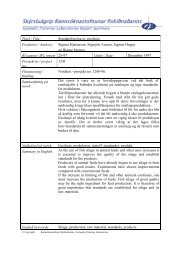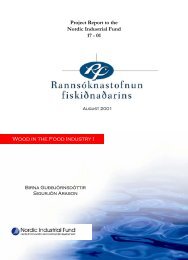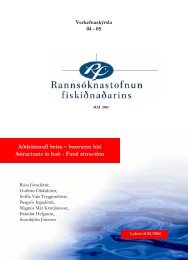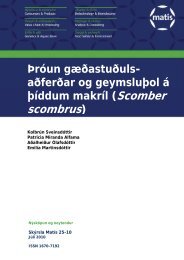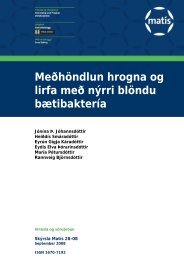Microbiology and Spoilage Trail in Nile Perch (Lates niloticus), Lake ...
Microbiology and Spoilage Trail in Nile Perch (Lates niloticus), Lake ...
Microbiology and Spoilage Trail in Nile Perch (Lates niloticus), Lake ...
You also want an ePaper? Increase the reach of your titles
YUMPU automatically turns print PDFs into web optimized ePapers that Google loves.
East Africa. The lake produces a fish catch of over 800,000 tonnes fish annually that currently<br />
leads to worth about US $590 million of which US $340 million is generated at the shore <strong>and</strong><br />
a further US$ 250 million a year is earned <strong>in</strong> exports from the <strong>Nile</strong> perch fishery. The lake<br />
fisheries employee’s as direct or <strong>in</strong>direct, almost 2 million people with household <strong>in</strong>comes<br />
<strong>and</strong> meet the annual fish consumption needs of about 22 million people <strong>in</strong> the region. The<br />
fishery is supported by three ma<strong>in</strong> important fish stocks, the <strong>Lates</strong> nilotucus (<strong>Nile</strong> perch),<br />
Rastr<strong>in</strong>eobola argentea (Dagaa/Sard<strong>in</strong>es) <strong>and</strong> Oreochromis <strong>niloticus</strong> (<strong>Nile</strong> Tilapia). Whereas<br />
over 75% of <strong>Nile</strong> perch is send directly to fish establishment for process<strong>in</strong>g <strong>and</strong> export to<br />
overseas especially to the lucrative European Market, while dagaa <strong>and</strong> tilapia serve the local<br />
region <strong>and</strong> domestic markets. <strong>Nile</strong> perch contribute about 60% of the total catch from the lake<br />
fishery supplies of which over 80% of the total fish <strong>and</strong> fish products have been exported to<br />
abroad/overseas markets.<br />
Accord<strong>in</strong>g to the Fisheries Division (FD) annual statistics report (2008). The total fish<br />
production <strong>in</strong> 2007 was 332,179.48mt whereas 98.68% (327,806.5mt) of production was<br />
from artisanal fisheries. Total revenues collection was about TZS 213 billion which<br />
generated TZS 7.5 billion as royalty. The fishery exports from <strong>Lake</strong> Victoria alone<br />
contributed about 92% of the total export where <strong>Nile</strong> perch fillets contributed 74% <strong>and</strong><br />
other <strong>Nile</strong> perch products <strong>and</strong> dagaa 13%. <strong>Lake</strong> Tanganyika contributed about 4% while<br />
Mar<strong>in</strong>e fishery export contributed about 5%. These fisheries employ more than 160,000<br />
direct fishers <strong>and</strong> about 4 million others <strong>in</strong> fisheries related activities. The overall<br />
contribution of fisheries sector to the economy of the country is 10% <strong>and</strong> to the Gross<br />
Domestic Production (GDP) about 3%.<br />
1.1 QUALITY AND SAFETY ASSURANCE OF EXPORTED FISH AND FISH<br />
PRODUCTS FROM TANZANIA<br />
Fish quality control st<strong>and</strong>ards <strong>and</strong> market<strong>in</strong>g section under Fisheries Division (FD) <strong>in</strong> the<br />
M<strong>in</strong>istry of Livestock Development <strong>and</strong> Fisheries is responsible for monitor<strong>in</strong>g,<br />
surveillance, quality control <strong>and</strong> certify<strong>in</strong>g fish <strong>and</strong> fishery products to meet national <strong>and</strong><br />
<strong>in</strong>ternational quality st<strong>and</strong>ards. This is enacted by the Fisheries Act No. 22 of 2003 <strong>and</strong><br />
Fisheries Regulations of 2005. Thus <strong>in</strong> order to efficiently implement these roles, FD<br />
established a National Fish Quality Control Laboratory (NFQCL)-Nyegezi <strong>in</strong> 1997 at <strong>Lake</strong><br />
2




